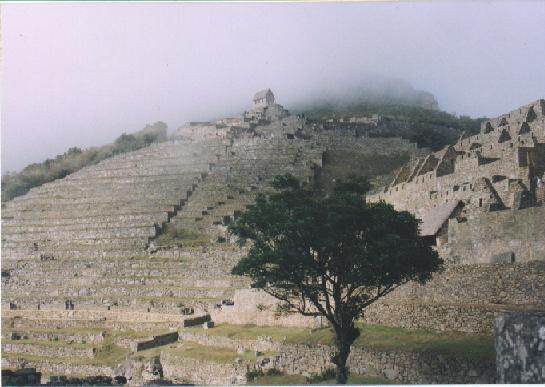TRAVEL JOURNAL

See Machu Picchu Photo Gallery
September 13, 2003
The View from Machu Picchu
The standard tourist promotion pictures of Machu Picchu show the familiar pointed peak in the background and the terraced ruins in the foreground. The tourist brochures all show a variation of essentially this view. This is the view that means Machu Picchu to the proverbial man on the street. It is instantly recognizable, almost an icon.It's a sort of visual signature. In a postage stamp you can portray Machu Picchu with some variation of that general view, give or take 20 degrees in its angle. There are many subtle variations in color and view, but certain fundamental elements are always there and identify it as Machu Picchu. The reason that view has become the most well known is because that angle is the best one for getting the most of the city into the frame, and capturing the imposing peak towering over the city, which is essential for portraying the recognizable Machu Picchu image.
What you never get from the standard pictures is the sheer magnitude of the place. They never capture the vastness, the labyrinthian sprawl of Machu Picchu.
I knew without going there that the pictures could not begin to portray the multidimensional beauty of such a place as Machu Picchu. I knew it would hit me in the face when I got there. And it did. But I also realized that as fascinating as the ruins are, the Conrad Hilton maxim fits: location, location, location.
The best thing about the city was where it was built. It is in a place of such breathtaking beauty that it makes you want to bow down and thank the Incas just for drawing our attention to the place. There must be untold millions of equally miraculous places on the great planet earth, but this one is brought into our human consciousness by its selection by the Incas -- or whoever it was -- that built that city in that place.
But even though they are almost incidental to the vast natural wonder upon which they sit, the ruins themselves are of a mass and complexity that is comparable to the great monuments of Egypt.
It's like having a ruin of the magnitude of the Pyramids in an environmental wonder on the scale of the Grand Canyon.
The peak that is always in the pictures is actually Wayna Picchu, the smaller of two mountains that are joined by a ridge on which the ancient city was built. The other peak is Machu Picchu. It's orders of magnitude larger than Wayna Picchu. If Machu Picchu were the size of the United States, Wayna Pichu would be Florida.
Macchu Pichu is a long ridge of a mountain. The city actually sits on an extension of it. Machu Picchu is the vantage point from which the standard pictures are taken, always looking down on the city and Wayna Picchu. Beyond Machu Picchu are rows of mountain ranges in the Andes, higher and higher still up to the snowy peaks against the horizon.
The photographs cannot begin to portray the power of the natural environment in that place.
I was at the site at sunrise, but the whole area was submerged in clouds, a thick fog, so the legendary Machu Picchu sunrise was not visible directly. The fog gradually lightened and night changed to day. After the sun was up, it heated the atmosphere and the fog began to lift, creating one of the most dynamic, splendorous spectacles imaginable. Clouds began to lift visibly, bunches of thick water vapor moved upward quickly, moving upward, like curtains rising and revealing the rocky mountains, forests, terraces, steep cliffs leading deep down into valleys down below to the glistening river. The sun just over the horizon of snowy peaks in the distance sent horizontal rays over the mountain peaks brilliantly illuminating clouds that still clung to the peaks, creating a constantly changing, breathtaking spectacle 360 degrees around. It was overwhelming.
If you were photographing, every second was a new photograph, every square of the enormous visual field. If you saw a possible photograph and paused to wind the camera, the scene was gone and replaced by another.
What a place it must have been to live! I think of our modern western civilization with all its hubris, the unshakable belief in its own superiority over all time and space, and I imagine a dweller of this city contemplating us sitting in our little cubicle homes, our heads virtually fastened to flickering cathode ray tubes, thinking how great we are. There in Machu Picchu there would be no need of TV images. Nature itself provides an ongoing, ever-changing show, an unsurpassable spectacle. How self-contained and complete life must have seemed. They must have felt there was nothing more to achieve for a perfect life. Until the Spanish came.